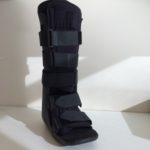Dealing with Foot Fractures
Foot fractures are a common problem affecting many people around the world.The human foot has 26 bones, 107 ligaments, 33 joints, and 19 muscles and tendons. Together your two feet contain around 25 percent of all the bones in your body. Combine this with the fact that your feet are the only part of your body in actual contact with the ground when you walk, and it’s no surprise that injuries like foot fractures occur.
What causes Foot Fractures?
The most common type of foot fracture is stress fractures. This means there is either severe bruising or a small crack in the bone. Stress fractures are usually caused by repetitive activity and overuse of the foot.
Others causes of Foot Fractures
Having poor posture when you exercise can also lead to a stress fracture, due to the improper balance of weight distribution. Also, increasing the intensity of your workout, changing surfaces, or trying a new exercise can lead to foot fractures.
If you have osteoporosis you are at a much higher risk for getting foot fractures as well. Your bones are constantly repairing themselves and creating new bone matter to replace the old stuff. When you start breaking down your bones faster than they can repair themselves this oftentimes leads to foot fractures. Usually, the damage done is not enough to cause a complete break, but rather leads to a stress fracture.
Which are the most common bones for a stress fracture?
Stress fractures most often happen in the foot between the 2nd and 3rd metatarsal. This is because these bones are thinner than the first metatarsal and receive the greatest amount of impact when you walk or run. Other common places for foot fractures are on the top of your foot in the navicular, in the heel, talus, and fibula as well.
How will I know if I have a foot fracture?
The most obvious sign that you have developed a foot stress fracture is a pain in the foot or ankle. It generally starts out rather unnoticeably, and gets worse and worse through continued overuse of the affected area. Other indicators of foot fractures include pain that goes away when you rest, pain that gets worse during normal activities, bruising, swelling, and tenderness to touch. If you suspect you might be suffering from a foot fracture, it is advised that you see a physician right away. If it is just a stress fracture, it could turn into a complete foot fracture which will take much longer to heal.
How do I reduce the risk of a complete fracture
Your first line of defense against foot stress fractures should be the tried and true RICE method. Rest the affected area by staying off your feet unless you absolutely have to bear weight on them. You can use crutches, or a special shoe with a thick sole to provide you relief when you need to get around. Icing the area multiple times a day will help reduce swelling as well. Use a cold pack or ice wrapped in cloth for twenty minutes to a half-hour at a time for the best results. Over-the-counter medicines may also help to reduce swelling and pain.
What if the pain doesn’t go away
The conservative measures, mentioned, can make your pain go away but if your pain does not subside, its time to see a podiatrist or doctor. At the doctors, they will take an x-ray of your foot to see if there is indeed a foot fracture, and how serious it may be.
What else can I do if the pain is not going away?
Most often you will need to let your foot rest until it is healed. Semi or non-weightbearing. Often the pain will tell you if you are not resting enough. If the foot fracture is serious you may need surgery or an immobilization cast or camboot to take care of the problem. Surgery could mean having plates, screws, or pins inserted into your foot to hold your bones together while they heal.
How long will I have to limit my activities?
 Depending on the severity of the fracture in your foot, it could take anywhere from six to eight weeks for full management, recovery, and rehabilitation. Complete foot fractures can take even longer. Once you aren’t feeling pain in the affected area anymore, your doctor will take another x-ray and may even order a CT scan if the fracture was hard to spot. If your foot fracture is fully healed you can begin walking normally again and slowly ease back into more strenuous activity. For athletes and people used to moving all the time, it can be hard to stay off your feet for as long as required. It is absolutely crucial that you do so, however, as failing to do so can lead to more serious problems and even permanent complications in your foot. Foot fractures can cause you many problems, it’s important to treat them properly.
Depending on the severity of the fracture in your foot, it could take anywhere from six to eight weeks for full management, recovery, and rehabilitation. Complete foot fractures can take even longer. Once you aren’t feeling pain in the affected area anymore, your doctor will take another x-ray and may even order a CT scan if the fracture was hard to spot. If your foot fracture is fully healed you can begin walking normally again and slowly ease back into more strenuous activity. For athletes and people used to moving all the time, it can be hard to stay off your feet for as long as required. It is absolutely crucial that you do so, however, as failing to do so can lead to more serious problems and even permanent complications in your foot. Foot fractures can cause you many problems, it’s important to treat them properly.



